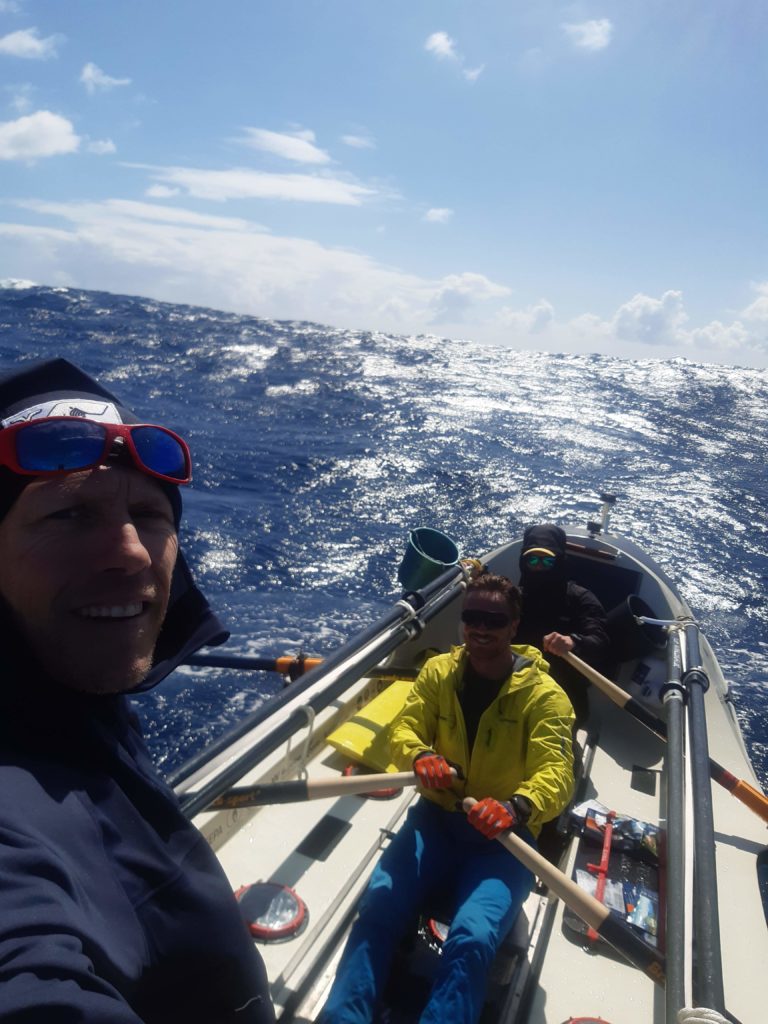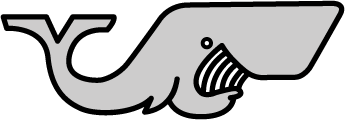
*** Front Row *** Captain’s log extracts ***
We set off from Portimaõ, Portugal on the 25th of February at 10.15 am, after careful deliberation with our weather router Fritz. Weather conditions were far from perfect to start, 4m waves from the WNW – remains of a mid-Atlantic storm – and wind from the WNW. Quite a rough start, but not to worry, things should improve the following days.
The goal was to head out as far west as possible, then go south, pushed by the prevailing north winds. Once south of Madeira we would start the crossing west, even as high as the 28th latitude! A cunning plan this was, the standard route is to start the crossing between the Canaries and Cabo Verde, latitude 19th and lower, the easier option because of the more constant trade winds pushing the boat across. But going this far south would make the trip to Miami even longer! And we had an extra 1350 NM/ 2500 km to row even as the crow flies, on top of the 2700 NM/ 5000 km for the crossing.
Unfortunately, from the first night Jelle got seasick and Gijs and I had to rearrange our shifts, meaning even less sleep. Well, no biggy I figured, seasickness in these conditions is part of the game. In fact I was expecting this to happen. When Jelle and I rowed along Indonesia before, he got seasick often. Besides, I wasn’t feeling too great myself. Building the new boat, setting up the campaign, finding sponsors in these challenging times, all within 1 year, appeared to had influenced my sea-legs! I felt exhausted and nauseous. Even threw up an orange juice, quite the surprise for me! Never had been seasick in my life.
During the second night we crossed the street of Gibraltar and the TSS. Supposed to be a bit of a navigational hazard but it turned out fine, nothing like rowing our boats across the English Channel to Belgium, crossing the busiest shipping lane in the world.
Wind coming from the NNW, at 20 kn and a WNW swell made rowing difficult. We used the daggerboard to minimise the roll, making Jelle very happy, but slowing the boat down slightly.
Three days into the row, Gijs had a swollen knee, inflamed tendon, probably caused by pushing his limits those first days. He had to switch to fixed seat rowing. Luckily seasickness didn’t seem to bother him at all, so he fed Jelle, emptied his bucket (a couple of minutes later😊) and nursed him like his momma would have done. Cooking, searching for wet food deep below or even playing with the plotter for hours on end, it didn’t seem to bother him at all!
So we had a vomiting rower, a first mate with a knee the size of a pineapple and an exhausted captain. A great start for sure!
The weather didn’t help either, dark stratocumulus clouds, pouring down heavy squalls on us. On top of it all, a broken sea state with steep, big waves. Wind exceeding 25 kn and a short wave period! This was not what I had in mind, that big, blue long Atlantic swell! And the nights were remarkably colder than I had expected. Soaked feet all through the day and night. We slightly underestimated the temperatures of this first leg of the trip, focusing too much on the warmer conditions later on. Rowing naked did seem far, far away!
Despite the conditions, we managed to hold a southwesterly course for the first week. But at a cost. In retrospect, rowing was hard and going parallel to the WNW swell and having the N to NW wind pushing the back of the boat sideways the entire time, rowing was extremely hard and pretty exhausting for the crew. Maybe we should have taken a more southerly course, saving energy…
It wasn’t all misery and pain, we saw a lot of travelling sea turtles, on their way to another continent, unimpressed by our space ship, even when on collision course, and packs of dolphins, chasing clouds of flying fish. Even sighted a solitary whale. And a lot of Pelagic birds of course, boobies, gannets, sterns and the storm petrels, beautiful little creatures but sure signs of rough conditions coming up.
On the seventh day, at sunrise, we were rowing against the wind for an hour or two, averaging 1 kn , and decided to call it a day. The wind had backed out to the W during the night, blowing 25+ knots. Time to bring out the para anchor. Being on para anchor in rough conditions is no joke. The boat was being thrashed around by the huge waves. We had to hide inside the cabin. Jelle and Gijs in the front cabin, and I was in the aft cabin. Being in the front cabin was like going on a rollercoaster. Your insides get pressed into all corners of your body.
In the aft cabin it felt like the boat was dropped in the water from a height of 2 m, with what sounded like an explosion whenever the stern would smash into the water.
On the positive side, we didn’t capsize, which has happened to a lot of other boats when being on para anchor in similar conditions. The Jan Martens performed as planned and that at least made me happy.
And we had a little bonus: a well deserved ‘rest’ from rowing.
After more than 40 hours on para anchor it was time to get back on the oars.
I noticed the NW swell was still there…
Just for the fun of it, we got one of the repeaters to display an old school ‘speedometer’, with a needle and a red zone, and a speed limit of 10 knots. When surfing down the big swell we were anxiously watching our speedometer, like little kids, and every time the needle hit the limit, exceeding the 10 knots, we were cheering, hoping the next wave would be even bigger. Made me feel like surfing our C23 surfboat at home, hitting the 20 knots one day!
All the while, Jelle’s seasickness wasn’t improving, in fact it got worse every time the conditions worsened. I think by that time I started to realise this might become problematic… My own nausea from the first days was a distant memory, and Gijs continued to be fine, stoically reading his e-reader in between shifts, inside the front cabin, with a bucket of Jelle’s vomit next to his face! We decided to change his nickname from ‘hands of destruction’ to ‘iron stomach’ .
Things got pretty nasty sometimes, with crashing, soaking waves. And once, when another big wave had crashed on deck, we saw nothing but spray and white foam around us. When the water left the boat, the next thing we noticed was Gijs, laying on deck, barefoot, and his shoes still nicely strapped to the footplates. The wave had blown him straight out of his shoes! That made us laugh pretty hard.
Luckily, in the evening of day 8 the ocean calmed down and we decided to stop the boat and relax a bit. We got the drone out for a spin and used our BGAN to send some messages home. The night was beautiful, full of stars, we could see the nebula in the lower part of Orion. Luminescent algae at the tips of our blades. Life was good…
Brutally awakened by a 20knt NNW in the morning. There we go again!
Were the hell are those NE winds…?!
Apart from the animal encounters, close encounters with commercial ships were a daily threat and keeping a good lookout for them was paramount. At night the AIS alarm system brought peace of mind when on potential collision course with these big boys.
Bleep- bleep- bleep (alarm sounding)
“Jan Martens, this is bulk carrier Kimri. What are your intentions please? Are you adrift?”
“Bulk carrier Kimri, Jan Martens. We are not adrift, we are an ocean rowing boat travelling at 3 knots. Please alter course.” 😊
I kinda liked the nightly conversations with the (mainly) Indian officers over the VHF. Friendly guys, immediately offering to do the necessary to avoid collisions. Even when piloting a 420 m oil tanker, surely bound to very tight schedules and losing money each second for a tiny object bobbing before their bulbous bow and obstructing their path. Nothing like the stories you hear about unmanned bridges, or bullies for captains, refusing to alter course!
Still no sign of the NE trade winds…
By Wednesday, day 14 at sea, it became clear that it was over. Jelle had tried to do a nightly shift but got back into has cabin, exhausted, unable to hold even fluids inside. Severe dehydration was right around the corner. In the morning I asked for a ‘meeting’ and made the final decision: Tenerife, Santa Cruz would be our next stop, not Miami. This was our last chance to get to land and seek medical help.
Late afternoon on the 15th day a big container ship came very close and seemed to slow down. It wasn’t long before I got a message on VHF, the captain of the vessel: ‘Can we be of any assistance?’
HUH? What? I’m not sure I understand. What are your intentions please?!
The captain explains that the MRCC Las Palmas asked him to divert his course to check on us. Apparently our land based team had informed the MRCC about Jelle’s deteriorating condition and the MRCC kindly relayed the message to nearby ships.
I thanked the Captain and informed him that we would make it to Tenerife on our own means, with an ETA of Friday, late afternoon, and off they went like a rocket, on a totally different course, the chimneys spitting out black smoke. They really did make an effort to come and help us! Another fine display of that old sea habit to help each other out, big or small.
Throughout the day we could feel the wind veering slightly to the East! And by Friday morning 12th of March that long awaited ENE wind gently pushed us in the right direction! Finally!
And according to our weather router the wind would remain perfect for the upcoming weeks, A free ride to the other side! For me personally the most frustrating moment of the trip, having to end it, knowing the conditions were finally in our favour…
A few hours later we reached the friendly port of Marina Puerto Chico, with a little help from the local crew to make it during daylight hours.
*
One of the most rewarding moments of the trip was seeing the similarities between the flight of the pelagic birds and us, surfing from one wave to another. Touching the waves with the tips of our blades, just like the birds glide from one wave to another, delicately dipping the tips of their wings into the water.
*
Back on land now, physically recovered, starting to set up a new expedition to Miami 😊 Thanks again to our sponsors for the support. We will get there!
Total distance rowed: 800 NM/ 1500 km
Portimaõ (Portugal) to Santa Cruz (Tenerife).
Capt.Koen
Learn more about the Front Row ocean rowing project on www.jointhefrontrow.be
—
Main partner: Libeco Belgian Linen
—
Creative geniuses: Yanina and Felix at www.andreleon.be
—

0 Comments
Leave a comment